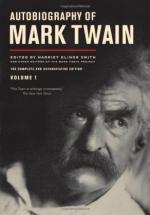|
This section contains 307 words (approx. 1 page at 400 words per page) |

|
To understand the critical reception of The Autobiography of Mark Twain, one must examine the context in which all of the versions were created and released, the intentions of each editor, and the debate over the works that continues today. Twain's autobiography, in the form that he intended it to be released, exists in the form of a massive, 400,000-word typescript he created in the final years of his life. The manuscript is largely composed of nonchronological, freeform dictations that Twain made to Albert Bigelow Paine, his official biographer, from 1906 until his death in 1910. During these dictations, Twain would say whatever came into his mind, mixing present and past events as he saw fit. Says E. Hudson Long in his Mark Twain Handbook, "Mark's intentions were to make his autobiography a combination of daily diary and memories from the past, a contrast he believed would add...
|
This section contains 307 words (approx. 1 page at 400 words per page) |

|




